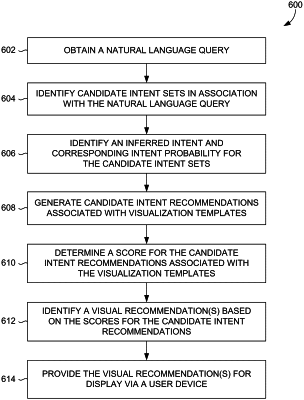| CPC G06F 16/3344 (2019.01) [G06F 16/338 (2019.01); G06F 16/3346 (2019.01); G06N 5/046 (2013.01)] | 20 Claims |

|
1. One or more computer storage media having computer-executable instructions embodied thereon that, when executed by one or more processors, cause the one or more processors to perform a method, the method comprising:
identifying an intent keyword and a corresponding intent attribute from a user input natural language query;
determining an inferred intent and corresponding intent probability associated with the natural language query by inputting the intent keyword and the corresponding intent attribute into a plurality of intent inference models that infer intent, wherein each of the intent inference models of the plurality of intent inference models corresponds with a particular intent of a set of predetermined intents corresponding with a dataset, wherein at least a first intent inference model of the plurality of intent inference models, based on the natural language query, infers a visual design intent for one or more attributes for presenting the dataset as a data visualization;
selecting a visualization template from a set of visualization templates based at least in part on the visual design intent;
generating a candidate intent recommendation that recommends the visualization template, wherein the candidate intent recommendation includes dataset intent data, visual design intent data, and insight intent data and at least one of the data intent data, visual design intent data, and insight intent data corresponds with the inferred intent;
determining a score for the candidate intent recommendation associated with the visualization template using intent probabilities and/or popularity probabilities associated with each of the dataset intent data, visual design intent data, and insight intent data of the candidate intent recommendation; and
providing, for display, a visual recommendation including the visualization template and at least a portion of the dataset intent data, visual design intent data, and insight intent data.
|